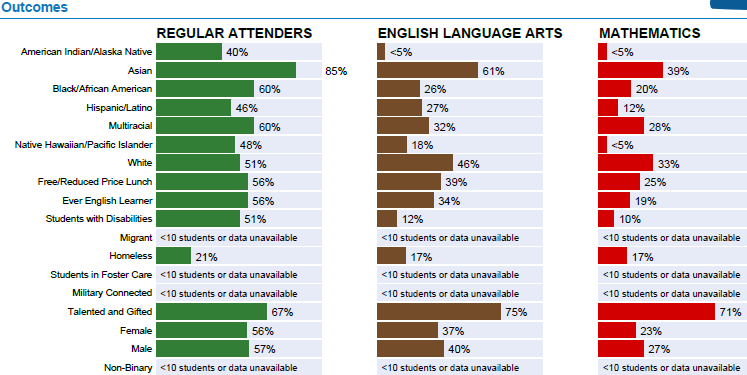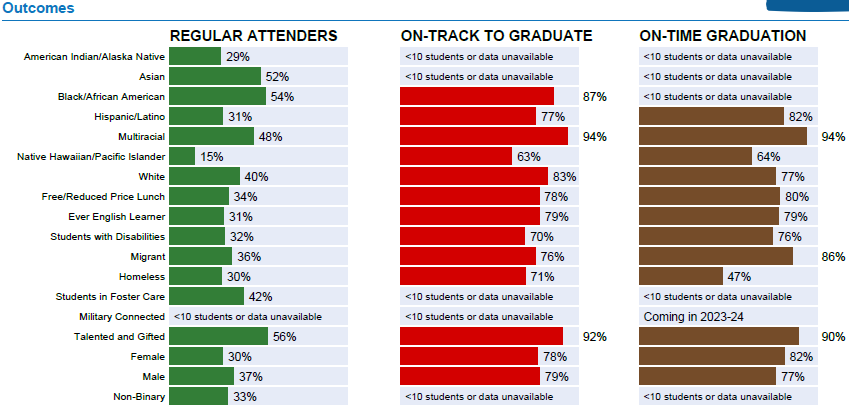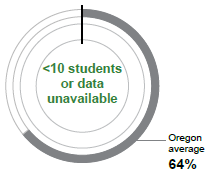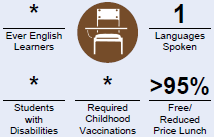Academic Success (page 1)
The Academic Success section varies by school type (elementary/middle or high school).
Elementary/Middle
The Academic Success section for elementary and middle schools includes English Language Arts, Mathematics, and Science assessment results. This section also shows the Oregon state average and the percent change from the school’s previous year for each subject. Note that the state average shown is the state percentage for the grades served by the school. For example, for a school serving grades K-5, the state average would be the state average for grades 3-5.

High School
The Academic Success section for high schools and combined schools shows On-Time Graduation (four-year graduation rate), Five-Year Completion, and College Going. The College Going rate is the percentage of On-Time graduates who enroll in a postsecondary institution after graduating and within 16 months following the cohort’s graduation. This section also shows the Oregon state average and the percent change from the school’s previous year for each indicator.

School and State Goals, and Safe & Welcoming Environment (page 1)
The Oregon Department of Education (ODE) provides the State Goals section. The School Goals section is for schools to provide local context regarding the school’s priorities or goals for serving their students. The Safe & Welcoming Environment section is for schools to describe actions taken or resources used to create a safe, welcoming, and inclusive environment for all students and their families. Both the School Goals and the Safe & Welcoming Environment sections are submitted to ODE by school and district staff.

Outcomes (page 2)
The Outcomes section varies by school type (elementary/middle or high school).
Elementary/Middle
The Outcomes section for elementary and middle schools shows data for Regular Attenders, English Language Arts, and Mathematics,
disaggregated by eighteen student groups.

Outcomes
| Student Group | Regular
Attenders | English
Language Arts | Mathematics |
|---|
| American Indian/Alaska Native | 40% | < 5% | < 5% |
|---|
| Asian | 85% | 61% | 39% |
|---|
| Black/African American | 60% | 26% | 20% |
|---|
| Hispanic/Latino | 46% | 27% | 12% |
|---|
| Multiracial | 60% | 32% | 28% |
|---|
| Native Hawaiian/Pacific Islander | 48% | 18% | < 5% |
|---|
| White | 51% | 46% | 33% |
|---|
| Free/Reduced Price Lunch | 56% | 39% | 25% |
|---|
| Ever English Learner | 56% | 34% | 19% |
|---|
| Students with Disabilities | 51% | 12% | 10% |
|---|
| Migrant | <10 students or data unavailable | <10 students or data unavailable | <10 students or data unavailable |
|---|
| Homeless | 21% | 17% | 17% |
|---|
| Students in Foster Care | <10 students or data unavailable | <10 students or data unavailable | <10 students or data unavailable |
|---|
| Military Connected | <10 students or data unavailable | <10 students or data unavailable | <10 students or data unavailable |
|---|
| Talented and Gifted | 67% | 75% | 71% |
|---|
| Female | 56% | 37% | 23% |
|---|
| Male | 57 | 40% | 27% |
|---|
| Non-Binary | <10 students or data unavailable | <10 students or data unavailable | <10 students or data unavailable |
|---|
High School
The Outcomes section for high schools shows data for Regular Attenders, On-Track to Graduate (Ninth Grade On-Track), and On-Time Graduation (four-year graduation rate),
disaggregated by eighteen student groups.

Outcomes
| Student Group | Regular
Attenders | On-Track To
Graduate | On-Time
Graduation |
|---|
| American Indian/Alaska Native | 29% | <10 students or data unavailable | <10 students or data unavailable |
|---|
| Asian | 52% | <10 students or data unavailable | <10 students or data unavailable |
|---|
| Black/African American | 54% | 87% | <10 students or data unavailable |
|---|
| Hispanic/Latino | 31% | 77% | 82% |
|---|
| Multiracial | 48% | 94% | 94% |
|---|
| Native Hawaiian/Pacific Islander | 15% | 63% | 64% |
|---|
| White | 40% | 83% | 77% |
|---|
| Free/Reduced Price Lunch | 34% | 78% | 80% |
|---|
| Ever English Learner | 31% | 79% | 79% |
|---|
| Students with Disabilities | 32% | 70% | 76% |
|---|
| Migrant | 36% | 76% | 86% |
|---|
| Homeless | 30% | 71% | 47% |
|---|
| Students in Foster Care | 42% | <10 students or data unavailable | <10 students or data unavailable |
|---|
| Military Connected | <10 students or data unavailable | <10 students or data unavailable | <10 students or data unavailable |
|---|
| Talented and Gifted | 56% | 92 | 90% |
|---|
| Female | 30% | 78% | 82% |
|---|
| Male | 37% | 79% | 77% |
|---|
| Non-Binary | 33% | <10 students or data unavailable | <10 students or data unavailable |
|---|
About Our School (page 2)
The About Our School section varies by school type (elementary/middle or high school) and is submitted to ODE by school and district staff.
Elementary/Middle
For elementary and middle schools, this section has headings for Bullying, Harassment, and Safety Policies; Extracurricular Activities; Parent Engagement; and Community Engagement. The Bullying, Harassment, and Safety Policies subsection contains a summary of the school’s efforts to address bullying and harassment and promote safety. The Extracurricular Activities subsection describes student access to or key resources related to extracurricular activities. The Parent Engagement subsection describes actions taken or key resources used by schools to engage parents. The Community Engagement subsection describes actions taken or key resources used by schools to engage community members.

High School
For high schools, this section has headings for Advanced Coursework; Career & Technical Education; Extracurricular Activities; and Parent & Community Engagement. The Advanced Coursework subsection lists the school’s advanced courses available to students. The Career & Technical Education subsection includes the Career and Technical Education (CTE) courses offered to students or key resources related to CTE. The Extracurricular Activities subsection describes student access to or key resources related to extracurricular activities. The Parent & Community Engagement subsection describes actions taken or key resources used by schools to engage parents and community members.

Back to Top
What do the symbols mean?
There are three different types of symbols that can appear on the profiles:
- The less than symbol <
- This could appear, for example, in the phrase “< 10 students or data unavailable” which occurs whenever the total number of students available for a measurement is less than 10 students. Two examples where this occurs are shown in the following images.


- The greater than symbol >
- This could appear in front of a percentage to communicate that the actual value is greater than the percentage.
- The asterisk symbol *
- This could also appear when the total number of students available for a measurement is less than 10 students or the data are unavailable. To protect confidential student information from being revealed, the asterisk appears in place of the percentage.
